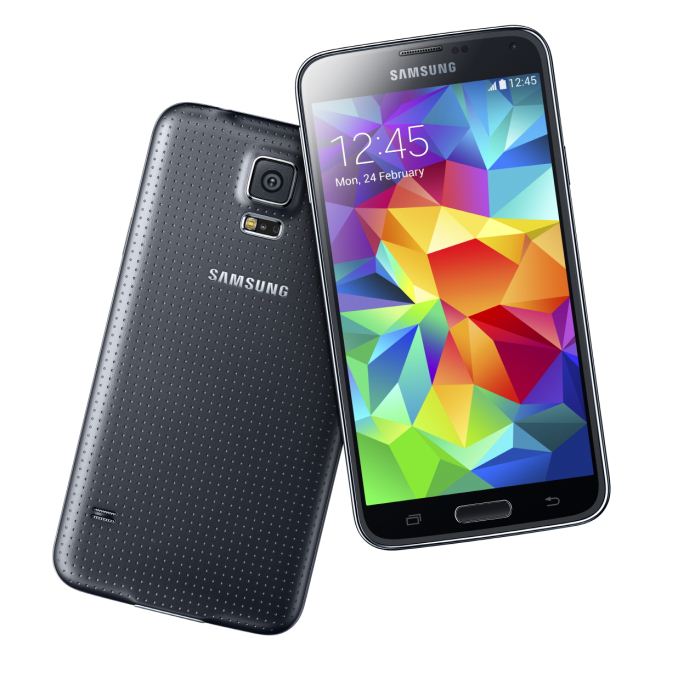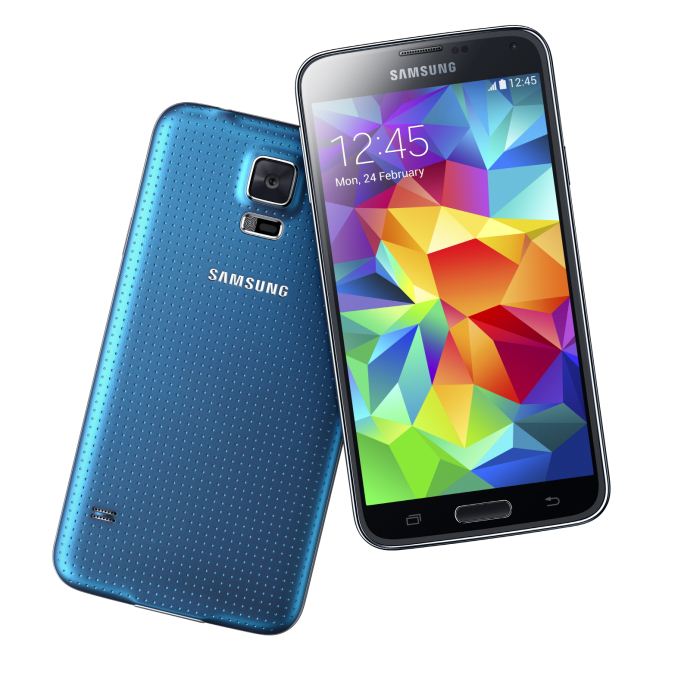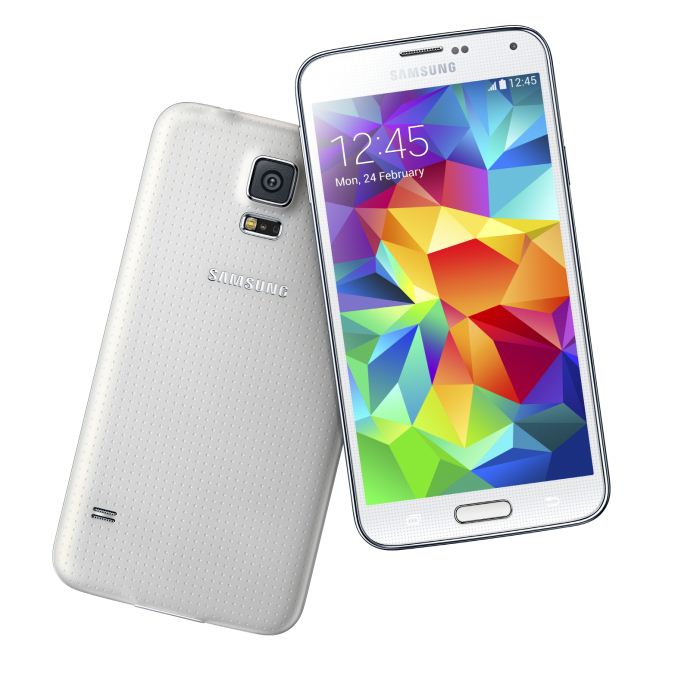Samsung Announces Galaxy S5: Initial Thoughts
by Joshua Ho on February 24, 2014 2:04 PM EST- Posted in
- Trade Shows
- Samsung
- Galaxy
- Smartphones
- Mobile
- MWC 2014

Every year Samsung launches a new Galaxy S flagship smartphone, and as always, Samsung puts the best platform that can be bought in their devices. The Galaxy S5 is no exception, as the MSM8974AC, or Snapdragon 801, powers the Galaxy S5. The 8974AC is the 2.45 GHz bin of the MSM8974AB, a slightly massaged MSM8974 that first launched with the LG G2 and other devices in the summer of 2013. As a recap, the MSM8974AB increases the clock speed of the Hexagon DSP to 465 MHz from 320 MHz, and the LPDDR3 RAM clocks go from 800 MHz to 933 MHz. What really matters though, is that GPU goes from 450 MHz to 578 MHz from 8974 to 8974AC. I definitely have to point to Anand's piece on the Snapdragon 801 for anyone that wants to know more.
The other portion of the hardware story is the camera, which is probably one of the biggest areas for OEMs to distinguish themselves from the pack. Samsung seems to be playing it safe this year with a straight upgrade from 13MP to 16MP by increasing sensor size, and pixel size remains at 1.12 micron side edge length. It is notable that the camera sensor seems to be in a 16:9 aspect ratio, which would make it possible for both photos and videos to keep the same interface without odd reframing effects when going from photo preview to camcorder functionality. Optics are effectively unchanged from the Galaxy S5, as the focal length in 35mm equivalent remains at 31mm, the aperture remains at F/2.2. The one area where there could be a notable improvement is the promised ISOCELL technology, which physically separates pixels better to reduce quantum effects that can lead to lower image resolution and also increases dynamic range, although this will require testing to verify the claims made by Samsung. Samsung has also added 4K video recording for this phone and real time HDR to extend the dynamic range of the camera.
The Galaxy S5 has 2GB of RAM, also not too surprising given the 32-bit ARMv7 architecture of the 8974AC.
The display is a 1080p 5.1” panel, which makes this phone around the same size as the LG G2. Samsung has definitely improved AMOLED, but first impressions are unlikely to tell much when it comes to the quality of calibration and other characteristics of the device. In all likelihood, this will continue to use an RGBG pixel layout in order to improve aging characteristics as the various subpixels age at differing rates. I would expect max brightness to increase, although this may only show in very specific conditions such as extended sunlight exposure and low APL scenarios.
The industrial design seems to be an evolution of the Note 3, with a texture that looks similar to that of the Nexus 7 2012. However, whether the stippled texture will actually avoid the long-term issue of a slimy/oily feel is another question that will have to be answered after the hands-on. While we're still on the point of the hardware design, the Galaxy S5 is IP67 rated, which is why the microUSB 3.0 port has a cover for water and dust resistance.
The fingerprint sensor is a swipe-based one, and Brian has voiced displeasure over swipe sensors like those found in the One max. I personally think that there could be some issues with ergonomics, as Samsung places the home button very close to the edge of the phone, which would make it rather difficult to swipe correctly over the home button, especially if the device is being used with one hand.
As always, Samsung has included removable battery and a microSD slot for those that need such capabilities, although now that Samsung is following Google guidelines regarding read/write permissions, the utility of the microSD slot could be much less than previously expected. For the battery, things are noticeably different as Samsung has gone with a 3.85V chemistry compared to the 3.8V chemistry previously used by the Galaxy S4. With a battery capacity of 10.78 WHr, this means that it has 2800 mAh. For reference, the Galaxy S4 had a 9.88 WHr battery with 2600 mAh.
As always, Samsung has put TouchWiz on top of their build of Android that will ship with the Galaxy S5, and it mostly looks the same. There are definitely some new features though like My Magazine, which seems to be a way of presenting multiple sources of information using a scrollable list of tiles with images on them.
There might be a trend here in the paragraphs, and while some may see it as a tic, it’s probably more representative of the consistency that Samsung is bringing to the table. “As always” means that people know what to expect, and while it may not be nearly as exciting to the tech press, average people live and die by what’s relatively familiar, not what’s new and exciting. The addition of new features and consistent improvements to performance without compromise relative to the previous generation is definitely something to be applauded, and with review units, hopefully it will be possible to see how the GS5 stacks up against the competition.
At any rate, the phone will launch with blue, black, white, and gold colors. It launches April 11 in 150 countries.













127 Comments
View All Comments
jjj - Monday, February 24, 2014 - link
Hope the fingerprint scanner can be fully disabled ,although not having it at all would be much better, no need to get our fingerprints spied on/stolen.The heart rate sensor is a nice addition and so is the 2x2 wifi but overall it feels like too little.We need exciting things.
Notmyusualid - Monday, February 24, 2014 - link
^^ This.pixelstuff - Monday, February 24, 2014 - link
Agreed. Where is the MRI scanner, DNA Sequencer, Wide Spectrum EM Imager, and other Tri-corder like stuff.Mondozai - Tuesday, February 25, 2014 - link
I don't want a day when you NEED to use biometric data for your smartphones, whether it is scanning your iris or taking your fingerprints but we are rapidly going into that direction.Unfortunately. If someone comes out with a smartphone without all of these things, they'll probably sell a lot for just that reason. (Of course, it isn't hard to see how governments around the world would force smartphone OEMs to include biometric data for all their devices to get around this).
Hulk - Monday, February 24, 2014 - link
Jeez. Now we have a couple more million useless pixels. Samsung, how about cutting the MP back to 10 and increasing photosite size? Seriously 10MP is more than adequate considering the tiny sensor size and low quality optics possible in a phone camera.Mondozai - Tuesday, February 25, 2014 - link
It's like the race for more CPU cores. It's not about rationality, it's about the FUD of lots of high numbers. People get fooled.Max(IT) - Sunday, March 23, 2014 - link
It's all about "numbers" .... more megapixel, more cores, more MHz ... it's a bait for customers.mil_1212 - Monday, February 24, 2014 - link
Talk about ugly color choices.Guspaz - Monday, February 24, 2014 - link
The big improvement made in the iPhone 5S fingerprint reader was that it's a 2D fingerprint scanner that can read your fingerprint when you press the home button in a normal fashion... you don't need to do anything extra compared to what you normally do. The reason previous 1D fingerprint scanners failed is because they required a separate and often uncomfortable action (scanning my fingerprint on my laptop was always a pain because of the awkward positioning). So Samsung is totally missing the point here.steven75 - Monday, February 24, 2014 - link
Samsung has never grasped subtleties, but that's because their goal isn't an overall more usable device, it's simply after ticking spec sheet checkboxes whether that makes the overall product better or worse.